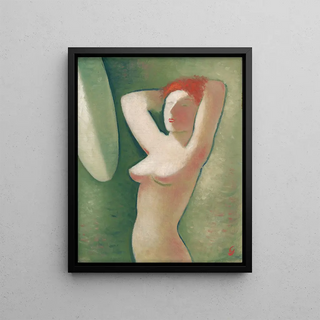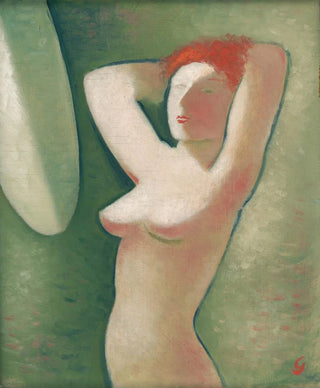Art print | In front of the mirror - Mikuláš Galanda Source: Reproduction | Devant le miroir - Mikuláš Galanda


View from behind

Frame (optional)
Art print of Mikuláš Galanda’s "Devant le miroir" – Captivating introduction
In the vibrant universe of art, some works stand out for their ability to capture the very essence of human existence. "Devant le miroir" by Mikuláš Galanda falls into this privileged category. This canvas, imbued with rare psychological depth, invites the viewer to a delicate introspection. The scene depicts a female figure, frozen in a moment of contemplation, a suspended instant where the reflection becomes the mirror of the soul. Through this piece, Galanda encourages us to question our own relationship with image and perception, immersing us in a universe where elegance and melancholy meet.
Style and uniqueness of the work
Mikuláš Galanda's style is characterized by a distinctive approach that blends realism with a touch of expressionism. In "Devant le miroir," the brushstrokes are both precise and bold, creating a vibrant atmosphere that transcends mere visual representation. The chosen colors, both soft and intense, play a crucial role in conveying the emotion of the piece. The light, subtly orchestrated, sculpts the forms and highlights the details, making the painting come alive. Galanda does not merely depict a scene; he explores its psychological depth, making each gaze, each gesture, laden with meaning. This ability to fuse technique and emotion makes this work a true masterpiece, an invitation to delve into the intimacy of being.
The artist and his influence
Mikuláš Galanda, an emblematic figure of Slovak art of the 20th century, left his mark on his era through his innovative approach and commitment to representing the human soul. Influenced by European artistic currents while remaining rooted in his Slovak origins, Galanda developed a style that is uniquely his own, oscillating between tradition and modernity. His work reflects a personal quest, that of understanding the complexities of human existence. Through "Devant le miroir," he offers us a window into his inner universe, while encouraging us to reflect on our own identity. His influence endures, inspiring

Matte finish

View from behind

Frame (optional)
Art print of Mikuláš Galanda’s "Devant le miroir" – Captivating introduction
In the vibrant universe of art, some works stand out for their ability to capture the very essence of human existence. "Devant le miroir" by Mikuláš Galanda falls into this privileged category. This canvas, imbued with rare psychological depth, invites the viewer to a delicate introspection. The scene depicts a female figure, frozen in a moment of contemplation, a suspended instant where the reflection becomes the mirror of the soul. Through this piece, Galanda encourages us to question our own relationship with image and perception, immersing us in a universe where elegance and melancholy meet.
Style and uniqueness of the work
Mikuláš Galanda's style is characterized by a distinctive approach that blends realism with a touch of expressionism. In "Devant le miroir," the brushstrokes are both precise and bold, creating a vibrant atmosphere that transcends mere visual representation. The chosen colors, both soft and intense, play a crucial role in conveying the emotion of the piece. The light, subtly orchestrated, sculpts the forms and highlights the details, making the painting come alive. Galanda does not merely depict a scene; he explores its psychological depth, making each gaze, each gesture, laden with meaning. This ability to fuse technique and emotion makes this work a true masterpiece, an invitation to delve into the intimacy of being.
The artist and his influence
Mikuláš Galanda, an emblematic figure of Slovak art of the 20th century, left his mark on his era through his innovative approach and commitment to representing the human soul. Influenced by European artistic currents while remaining rooted in his Slovak origins, Galanda developed a style that is uniquely his own, oscillating between tradition and modernity. His work reflects a personal quest, that of understanding the complexities of human existence. Through "Devant le miroir," he offers us a window into his inner universe, while encouraging us to reflect on our own identity. His influence endures, inspiring






